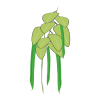Green Bean Pole (also known as pole beans) are a type of climbing green bean that grows vertically rather than spreading out in a bushy form. Unlike bush beans, which grow low to the ground, pole beans require support such as a trellis, fence, or stake to climb and reach their full potential. The plants can grow anywhere from 6 to 10 feet tall, depending on the variety, and produce long, slender pods filled with tender beans.
Pole beans are known for their high yields and longer harvest period compared to bush beans. As the plants continue to grow and produce, you'll often have beans available for picking over several weeks, making them ideal for gardeners looking for a more extended harvest. The climbing nature of pole beans also allows for better air circulation and easier harvesting, as the beans are lifted off the ground.
The beans themselves are typically harvested when the pods are firm and green, before the beans inside fully mature and cause the pods to become tough. Pole beans tend to take a little longer to mature than bush beans, with most varieties taking around 60 to 75 days from planting to harvest.
Pole beans are also nitrogen-fixing plants, which helps improve soil health by enriching the soil with nitrogen as they grow. They thrive in warm weather, and their climbing habit makes them ideal for gardeners with limited ground space, allowing you to maximize your garden’s vertical potential.
How To Grow
Growing pole green beans is fairly straightforward, but they do require some care, especially when it comes to support for their vining growth. Here's how you can successfully grow them:
-
Choose the Right Location
Sunlight: Pole beans need full sun, which means they should get at least 6-8 hours of direct sunlight per day.
Soil: Well-drained, fertile soil is ideal. Beans prefer soil with a slightly acidic to neutral pH (6.0 to 7.0). Enriching the soil with compost or organic matter will improve drainage and fertility.
-
Prepare the Soil
Loosen the soil to a depth of about 2-3 inches using a fork or tiller.
Add compost to enrich the soil and help with water retention and drainage.
Beans do not need excessive fertilization, especially nitrogen, as they can fix their own. If needed, use a balanced fertilizer to ensure healthy growth.
-
Planting
Timing: Wait until the danger of frost has passed and the soil temperature is consistently above 60°F (15°C). This is typically in late spring or early summer.
Sow Depth: Plant seeds 1 to 1.5 inches deep.
Spacing: Space seeds about 2-4 inches apart along your row. Rows should be about 18-36 inches apart.
Trellis: Set up your support structure (trellis, fence, or poles) before planting. Pole beans need vertical support as they grow. A trellis or other support should be around 6-10 feet tall, depending on the variety.
Watering: Water the soil well after planting to help with germination. Keep the soil consistently moist but not soggy.
-
Care During Growth
Watering: Pole beans need regular watering, especially in dry conditions. Water deeply at the base of the plant to encourage deep root growth. Avoid wetting the leaves, as this can promote fungal diseases.
Weeding: Keep the area free of weeds, as they compete for nutrients. Mulching around the base can help suppress weed growth and maintain soil moisture.
Trellis Care: As the plants begin to grow, gently guide the vines onto the trellis if needed. Pole beans will naturally climb, but occasionally they might need a little help to get started.
Pests and Diseases: Watch for pests like aphids, bean beetles, and caterpillars. You can treat them with organic insecticidal soap or neem oil if necessary. Beans are also susceptible to fungal diseases like powdery mildew, so ensure good air circulation around the plants.
-
Supporting the Growth
Trellis Maintenance: As the plants grow taller, the vines will naturally twirl around the trellis. Be sure to provide enough vertical space for the vines to climb. You may also want to tie them loosely to the trellis if the vines need extra support.
Pruning (Optional): You can pinch back the growing tips of the plants once they reach the top of the trellis to encourage more lateral growth and more beans.
How/When To Harvesting
Harvesting pole green beans is a straightforward process, but timing is important to ensure the beans are tender and at their best quality. Here's how to properly harvest your pole beans:
-
Timing the Harvest
When to Harvest: Pole beans generally mature 60-75 days after planting, depending on the variety and growing conditions. The beans are ready for harvest when the pods are firm, green, and fully formed, but still tender. Don’t wait too long, or the beans inside the pods can become tough and stringy.
Check Pods: Harvest when the pods feel full and the beans inside are not yet bulging or overripe. If the pods start to show signs of drying or becoming too large, the beans inside may become tough and less flavourful.
-
How to Harvest
Pick Regularly: For continuous production, it’s best to harvest beans every 2 to 3 days. This prevents overripe pods from reducing the plant’s productivity and encourages the plant to produce more beans.
How to Remove Pods: Gently pull the pods off the vines by hand. If the pods are difficult to snap off, you can use garden scissors or pruning shears to cut them from the plant, taking care not to damage the vines.
Be Gentle: Since the vines are delicate, avoid pulling or tugging too hard, as this can break the plant. Support the vines as you harvest to prevent damage.
-
After Harvesting
Fresh Use: You can eat pole beans immediately after harvesting. They are often best enjoyed fresh when they are still tender and crisp.
Storage: If you’re not using the beans right away, you can store them in the fridge for a few days. For long-term storage, blanch the beans (by briefly boiling them and then cooling them in ice water) and freeze them for later use.
Keep Harvesting: Continue harvesting beans as they ripen. Even if the plant starts to show signs of decline toward the end of the season, harvesting regularly encourages the plant to keep producing.
-
End of Season Harvesting
Final Harvest: Once the plant is no longer producing, and most of the beans have been picked, you can remove the vines from the trellis. If you want to save seeds for next year, allow the last few pods to fully mature on the vine until they dry out. Then, collect the seeds from the dried pods for planting the next season.


